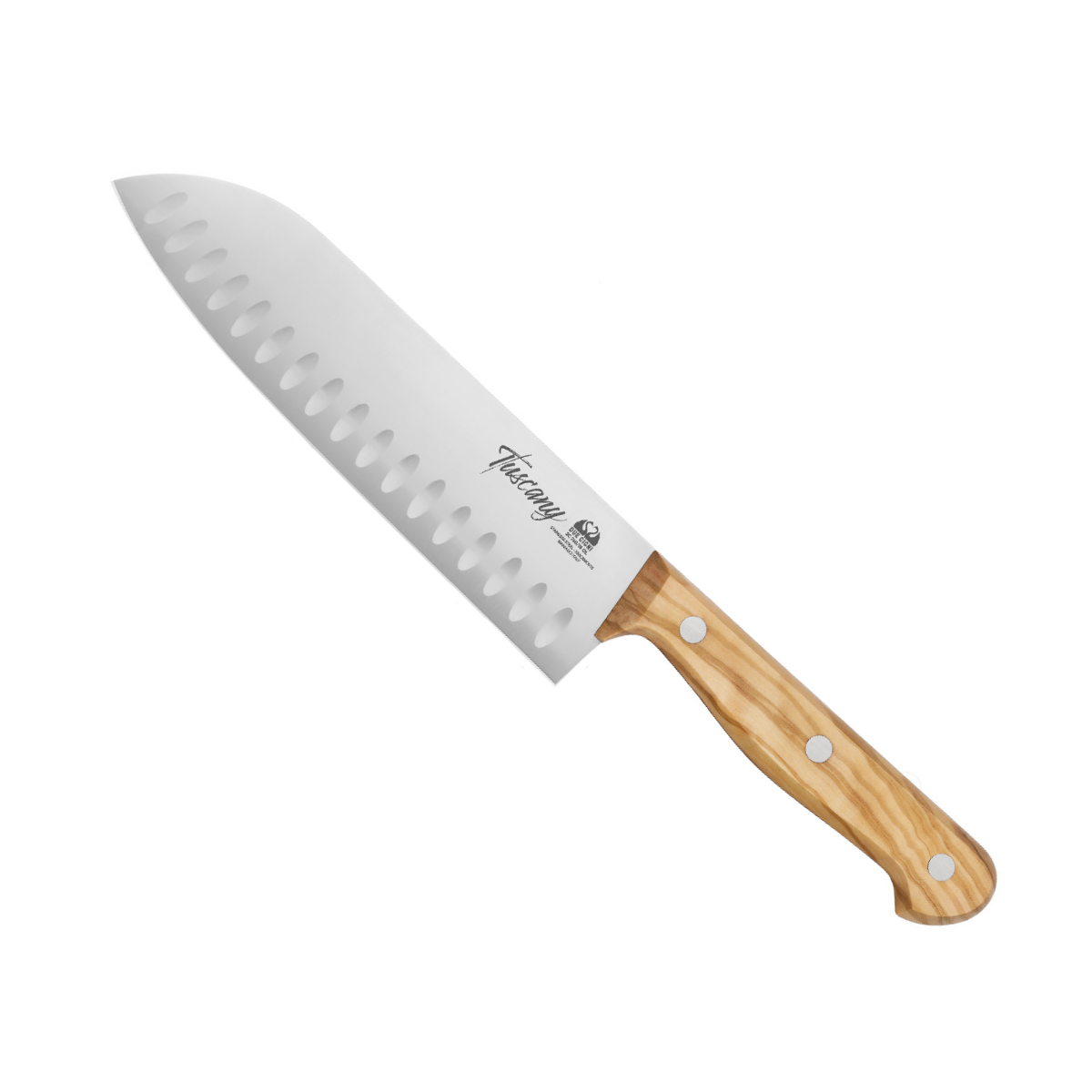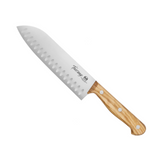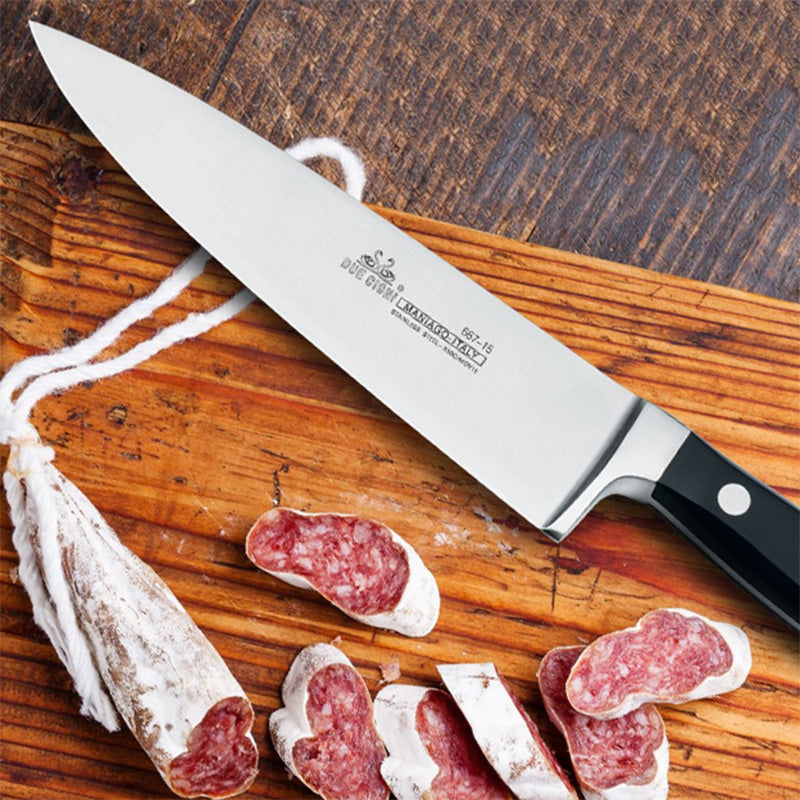Tuscany Santoku Knife
The Tuscany line Santoku knife from Due Cigni is the definition of sleek and refined. Our equivalent of a 7-inch blade is stamped with scallops from tip to handle, reducing weight for lighter and faster cuts will ensuring even the thinnest of cuts will come off complete and without sticking to the blade. The handle is made from olive wood, creating a sophisticated design when paired with the blades scalloping. For the best Santoku knife on the market, the Tuscany line Santoku knife is the natural choice.
Blade Steel: stainless steel 4119 nitro-B
Hardness: HRC 55-57
Blade Coating: satin
Handle: olive wood
Rivets: stainless steel
Blade Length: 18 cm - 7.09"
Overall Length: 30 cm - 11.81"
Blade Thickness: 1.5 mm - 0.06"
Weight: 128 gr - 4.52 oz
Dishwasher safe: no
What is a Santoku knife best for?
A Santoku knife is best for slicing, dicing, and chopping a variety of ingredients, including fruits, vegetables, and boneless meats. Its versatile design, with a sharp, flat edge and slight curve, makes it a go-to tool for tasks like preparing stir-fries, salads, and other dishes that require precision in the kitchen.
Click To Read All FAQS
What is a Tuscany Santoku Knife, and what makes it unique?
A Tuscany Santoku Knife is a Santoku knife with a handle made from olive wood. The use of olive wood adds a unique aesthetic and natural touch to the knife. Olive wood is known for its durability, attractive grain patterns, and comfortable grip, making it a distinctive and stylish choice for kitchen enthusiasts.
What are the key features and benefits of a Tuscany Santoku Knife?
A Tuscany Santoku Knife features a blade suitable for slicing, dicing, and chopping, with a unique olive wood handle for style and comfort. The knife combines versatility with an aesthetic appeal, providing a durable, sharp edge for various kitchen tasks while adding a touch of natural beauty to the culinary experience.
How do I choose the right Tuscany Santoku Knife for my needs?
When choosing a Tuscany Santoku Knife, consider blade material, size, and sharpness. Ensure the handle fits comfortably in your hand. Look for reputable brands and read reviews. Assess your specific cutting needs, and choose a knife that aligns with your preferences and kitchen tasks for a personalized culinary experience.
Are there safety tips for using a Santoku Knife?
Certainly! When using a Santoku knife, practice proper hand placement, keeping fingers tucked away from the blade. Use a stable cutting surface and maintain a controlled cutting motion. Keep the knife sharp for safer cutting. Avoid excessive force and prioritize a steady, deliberate pace. Store the knife properly to prevent accidents. Following these guidelines enhances safety and ensures a more enjoyable and secure cooking experience.
How should I clean and maintain my Tuscany Santoku Knife?
Hand wash your Tuscany Santoku Knife with mild detergent and warm water, avoiding harsh abrasives or the dishwasher. Dry it immediately to prevent corrosion. Regularly sharpen the blade using a honing rod or whetstone. Treat the olive wood handle with food-safe mineral oil to maintain its luster. Proper cleaning and maintenance ensure your knife stays sharp and in optimal condition.
What is the price range for Tuscany Santoku Knives?
The price range for Tuscany Santoku Knives can vary depending on factors such as brand, materials used, and overall quality. In general, you can find Tuscany Santoku Knives in a range from $30 to $150 or more. High-quality materials, craftsmanship, and brand reputation may contribute to higher prices.
Can I sharpen a Santoku Knife at home?
Yes, you can sharpen a Santoku Knife at home using a sharpening stone or honing rod. Follow the knife's original edge angle, maintain a consistent motion, and repeat on both sides until sharp. Professional sharpening services are also an option for optimal results. Regular maintenance ensures the Santoku knife stays sharp and effective in the kitchen.
Are there unique designs or features in Tuscany Santoku Knives?
Tuscany Santoku Knives often feature unique olive wood handles, adding aesthetic appeal and a comfortable grip. The combination of a sharp blade for versatile cutting tasks and the distinctive olive wood handle creates a visually appealing and functional kitchen tool. The knife's design reflects a blend of craftsmanship and style, making it stand out in terms of both performance and aesthetics.
Can a Tuscany Santoku Knife be a valuable addition to my kitchen?
Yes, a Tuscany Santoku Knife can be a valuable addition to your kitchen. Its unique olive wood handle adds style, while the sharp blade is versatile for slicing, dicing, and chopping. The knife's aesthetic appeal and functional design make it a standout choice for those looking to enhance both their culinary experience and the look of their kitchen tools.
Are there specific recipes or cuisines that benefit most from a Santoku Knife?
It's ideal for Asian cuisines like Japanese and Chinese, where fine chopping of vegetables and precise cuts are common. Additionally, it's excellent for salads, stir-fries, and other dishes with a focus on fresh, finely prepared ingredients, making it a versatile tool in the kitchen.
Can I find Santoku Knives with ergonomic handles?
Yes, many Santoku knives come with ergonomic handles designed for comfort and ease of use. These handles are crafted from materials like PakkaWood, G-10, or other composites, providing a secure grip and reducing hand fatigue during extended use.
What factors should I consider when gifting a Tuscany Santoku Knife?
Consider the recipient's cooking style, preferences, and kitchen needs. Choose a Tuscany Santoku Knife with a design or handle material that aligns with their taste. Opt for reputable brands known for quality. Include care instructions and maintenance tips. Ensure the knife complements their existing kitchen tools. Personalizing the gift to their culinary preferences makes it thoughtful and practical.
Can a Tuscany Santoku Knife also serve as a decorative kitchen piece?
The unique olive wood handle adds an aesthetic touch, making it visually appealing. When not in use, display it in a knife block or magnetic strip to enhance the kitchen's decor. Its combination of style and functionality makes it a versatile addition, both as a tool and a decorative item.
What are the primary uses of a Tuscany Santoku Knife in the kitchen?
A Tuscany Santoku Knife is versatile, excelling in slicing, dicing, and chopping. Its sharp blade makes it ideal for precise cutting tasks. Whether preparing vegetables, fruits, or boneless meats, the knife's design and sharpness contribute to efficient and enjoyable cooking experiences, making it a valuable tool in the kitchen.
How do I maintain the sharpness of a Santoku Knife blade?
Maintain Santoku Knife sharpness by regularly honing the blade with a honing rod or whetstone. Hand wash the knife with mild detergent and immediately dry to prevent corrosion. Avoid harsh abrasives and dishwashers. Store it in a knife block or on a magnetic strip. Regular maintenance ensures the Santoku Knife remains sharp and ready for precision cutting in the kitchen.
Can a Santoku Knife replace other knives in my kitchen?
While versatile, a Santoku Knife may not fully replace other knives. It excels in slicing, dicing, and chopping but may lack the heft for heavy-duty tasks. Keep a chef's knife for versatility, a paring knife for detailed work, and a bread knife for slicing bread. A well-rounded collection ensures you have the right tool for every kitchen task.
What materials are commonly used for Santoku Knife handles?
Common materials for Santoku Knife handles include PakkaWood, a durable and water-resistant wood composite. G-10, a fiberglass laminate, is known for its strength and resistance to moisture. Some knives feature handles made from various synthetic materials.
Are there any specific care instructions for wooden-handled Santoku Knives?
For wooden-handled Santoku Knives, hand wash with mild detergent and avoid soaking. Immediately dry to prevent moisture damage. Periodically treat the handle with food-safe mineral oil to maintain its appearance. Avoid harsh abrasives and dishwashers. Proper care ensures the longevity of the wooden handle and the overall performance of the Santoku Knife.
Blade Steel: stainless steel 4116 X50CrMoV15
Hardness: HRC 55-57
Blade Coating: satin
Handle: black POM
Rivets: stainless steel
Blade Length: 24 cm – 9.45″
Overall Length: 36 cm – 14.17″
Blade Thickness: 1.5 mm – 0.06″
SHIPPING
Most orders will be processed within one business day (we make sure our employees take Saturday and Sunday off, so if you order late Friday or over the weekend, we will process your order on Monday). When your order leaves our warehouse in Seattle, Washington, you will receive an email with your tracking number. Add 3 to 5 business days for delivery. Please note that we only ship within the United States.
RETURNS POLICY
We take pride in our workmanship and stand behind our products, which is why we accept returns within the first 30 days from the day your items arrive.
Collections
Products
Blogs





 Tuscany Santoku Knife
Tuscany Santoku Knife

 DueCigni Cutlery
DueCigni Cutlery

 DueCigni Cutlery
DueCigni Cutlery